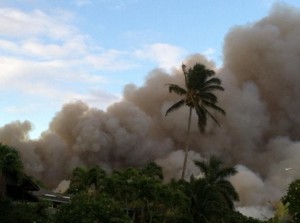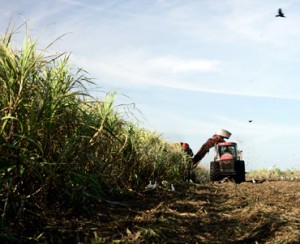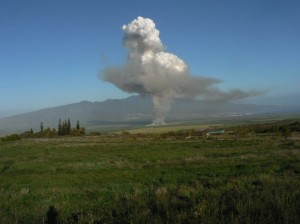LETTER: Profitable Solutions for Cane Industry, Without Ash
By Dennis Kleid, PhD (organic chemistry, molecular biology), Kihei
Hawaiian Commercial & Sugar has totally convinced me that they cannot produce sugar, safely, at a profit.
The open field cane burning process has been going on for well over 100 years and will not stop unless HC&S can find a use for un-burned cane. According to the experts, the cane must be burned if sugar is the final product.
Instead of sugar, what about a final product that is dried cellulosic material?
HC&S could harvest (cut and bale), two times per year without replanting, instead of every other year with burning and replanting. Depending on the amount of water used to grow the biomass product, HC&S could expect to produce 25 – 50 tons per acre per year. Times 30,000 acres, this is/or could be 1.5 million tons per year. At the present time one third of this biomass goes up in smoke and ash. This is one half a million tons of smoke and ash per year.
Presently, they are truly, “HC&Ash.”
ALEX Annual Report 2012
ITEM 6. SELECTED FINANCIAL DATA
Management’s Discussion and Analysis of Financial Condition and Results of Operations (dollars and shares in millions).
year 2012, 2011, 2010, 2009, 2008
- A&B Revenue: Agribusiness
- $m $182.3 $157.5 $165.6 $99.6 $121.6
- A&B Operating Profit: Agribusiness
- $m $20.8 $22.2 $6.1 $(27.8) $(12.9)
As you can see although the revenue is pretty good, the profits are not. This has been the story with this low profit, high cost business for years and years.
Just for example, in 2000, A&B’s 900 ag employees delivered $64 million in raw sugar (210,000 tons), with a cost of production of about $55 million, giving them a profit of less than $10 million.
They used 37,000 acres (of their total of 57,000 acres), for cane production and were able to harvest about half of that total acreage that year. By my calculation in 2000 this netted A&B a whopping $250 in earnings per total planted acre. (Although a one cent increase in raw sugar price would increase this by $4 million to net $350 per total planted acre.) In comparison in 1999 they delivered $83 million (288,000 tons), and in 1998 they delivered $79 million (260,000 tons) of raw sugar (source A&B annual reports).
As much as 200 million gallons of water a day are used from the East Maui irrigation system for this product.
These days, the approximate revenue per employee agribusiness 2012 is $182,300,000 / 800 = $227,000 per employee. Profits, $26,000 per employee. HC&Ash needs to stop open field burning and making sugar, and instead sell cut and bailed, or compressed cellulosic pellets from the un-burned cane. If cut before the cane stalks get full of water, this can be done. The revenue would be much less, but the profits would be much higher.
My question is, what is the value per ton of ready to ship cellulosic pellets for example, assuming a final moisture content of 10%, 20%, 30% ?
Also, part of their property could be leased for use by others that may be interested in growing nut, coffee, or fruit trees. All HC&Ash would need to do is identify parts of their property where the water and terrain would be useful for other crops, and hire a couple of sales reps (realtors). Who knows; $500 per year per acre would be solid profit, more than they get from the ash business.
—
Send letters to [email protected]. If you have a brief response to an article, please use the comments section below.













